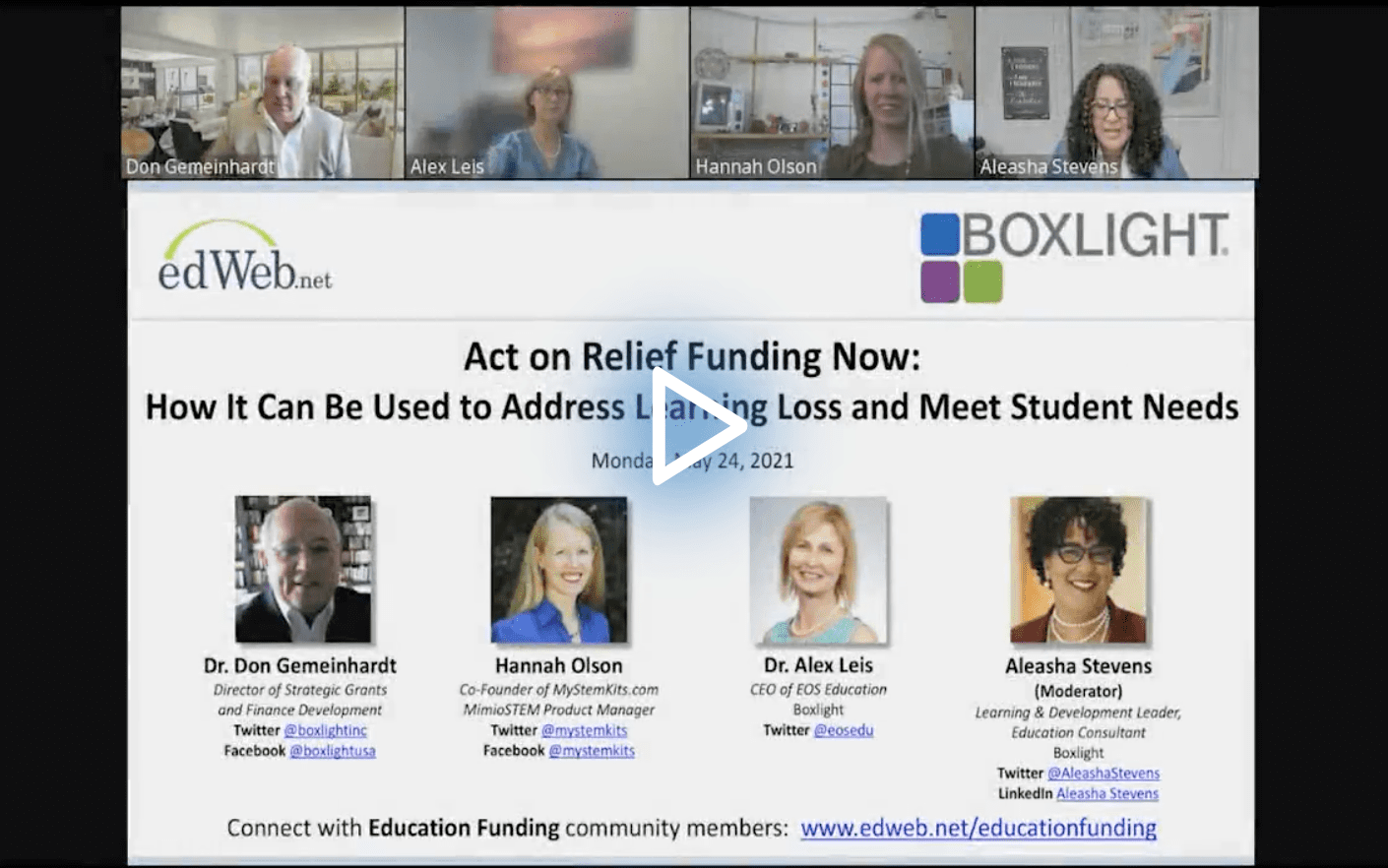Maximizing COVID Relief Funding and Its Effectiveness
Billions of dollars in federal relief funding for schools and districts have become available during the coronavirus pandemic, but with limited time available before application deadlines arrive, there is an urgent need to understand the funding requirements and process, and also to determine how the funds can best be used to provide improvements for local students and staff.
Key aspects of the federal relief programs and effective ways to utilize them were discussed during a recent edLeader Panel, sponsored by Boxlight. The featured panelists were Dr. Don Gemeinhardt, Director of Strategic Grants and Finance Development at Boxlight, Dr. Alex Leis, CEO of Boxlight-EOS, and Hannah Olson, Product Manager of STEM Solutions at Boxlight and Co-Founder of MyStemKits.
Dr. Gemeinhardt pointed out that only 60% of the initial relief funding for education was actually spent, due in part to the many crucial and fast-changing issues administrators were dealing with during 2020, so with vaccinations underway and plans for the new school year focused on a return to the classroom, this may be a better opportunity to obtain the full amount that districts can put to good use.
Federal Programs and Processes
Dr. Gemeinhardt explained that the original coronavirus (CARES) act and a supplemental appropriation (CRRSA) provided a total of $54 billion in K-12 funding, of which $2.75 billion was for private schools. In 2021, the America’s Response Program Act (ARPA) added $126 billion to those funds.
A very wide range of district programs can qualify for the latest funding, including access to school facilities, educational and professional development needs, and the use of technology to sustain and improve the educational environment. In addition to supporting students and faculty members, the funding can also be spent on programs involving parents and other community members.
More specifically, funding can be used for educational technology purchases such as hardware and software, physical and mental health services and support, and the implementation of summer and afterschool programs. Appropriate school facility repairs and improvements can also receive funding, as can programs that provide information and assistance to parents.
However, most states are requiring funding applications by July 31, 2021, and all states must obligate funding by the end of the current federal fiscal year, which is September 30, 2021. Specialized grants will continue to be available but may have more lengthy application processes and timeframes for the distribution of funds.
In order to maximize an application’s chance of success, Dr. Gemeinhardt emphasized the importance of providing a clear justification for the funding that matches the program requirements. This can take just a few paragraphs, followed by an explanation of what the funding will specifically be spent on and how much it will cost. The relatively simple format makes this process one of the easiest ways to obtain federal funding.
Maximizing the Impact of Relief Funding
Turning to ways that relief funding can provide the most benefit, Olson emphasized that STEM products should include high-quality student resources and instructional support for teachers, rather than relying solely on hands-on activities that are not integrated with a broader curriculum. Integrated training for teachers and ongoing tech support are also important aspects of a STEM purchase that will result in effective long-term teaching and learning.
In regard to professional development, Dr. Leis recommended that PD be interwoven throughout the complete range of educational resources being purchased, instead of a “separate bucket” used for just one or two specific purposes. This approach can be especially important when afterschool and summer school programs are being integrated with classroom instruction during the regular school day, and when funds are being used to meet the unique needs of English learners and other students with special learning requirements.
Dr. Leis pointed out that the relief funds provide an opportunity for professional development to be done in “the right way,” starting with a thoughtful planning and implementation process, and including work with teachers on an ongoing basis. This approach is more likely to provide educators with the ability to use all the tools in their classroom to meet the individual needs of their students and keep the students engaged in learning.
This edWeb broadcast was sponsored by Boxlight.
Watch the Recording Listen to the Podcast
About the Presenters
Don Gemeinhardt, Ed.D., MBA, MSS, (Colonel, Retired USAF) is Director of Strategic Grants and Finance Development at Boxlight. Dr. Gemeinhardt’s experience goes from teaching for 30 years both in and out of the Air Force to currently teaching in education, law enforcement, and business programs and as a curriculum developer in these areas. Dr. Gemeinhardt started out teaching in K-12 as an assistant teacher and from then on loved the educational and training field. After retiring from the Air Force in 2003 he worked for several years in the simulation training development area for the Research Triangle Institute in a wide variety of education, training and analysis efforts and wrote several papers in these areas. Through his own company, Educational, Development and Training (EDT) Systems Inc., he consults for various companies like Boxlight Inc., assisting organizations in grant and proposal efforts along with consulting in various DOD and DHS and DOE efforts in learning management systems.
Dr. Alex Leis is the founder and CEO of Boxlight-EOS Education, a leading provider of professional development services to educators and school administrators. The company specializes in large-scale PD implementation programs focused on teachers using technology to improve teaching and learning. Dr. Leis is an expert in the field and brings decades of both academic and business management experience in both Europe and the United States, including senior leadership positions at Ipsos, ImmediaEDU and now Boxlight.
Hannah Olson is a product manager at Boxlight and one of the co-founders of MyStemKits.com, now home to the MimioSTEM suite of curricula for all Boxlight STEM products. As part of her role, she focuses on developing engaging lesson plans and design challenges for K-12 STEM educators which utilize the Robo 3D printers, MyBot robots, and Labdisc sensors. She creates 3D-printable kits, design challenges, programming activities, and virtual kits so teachers can utilize their STEM technology easily and effectively in their classrooms.
About the Moderator
Driven by a passion for learning, Aleasha Stevens has dedicated her life to advocating for the needs of all learners as a classroom teacher, literacy program director, VP of education services, and now education technology consultant for Boxlight where she is leading the Boxlight Virtual Classroom where education professionals can experience best practices in technology evaluation, adoption and integration through virtual demonstrations. Aleasha’s lifelong love of learning has earned her bachelor’s and master’s degrees in education as well as professional certifications as a reading specialist, project manager, and classroom management specialist. In her spare time, Aleasha maintains her connection to the classroom by teaching English as a second language in France.
Join the Community
Education Funding is a free professional learning community on edWeb.net created to help educators and institutions uncover the funds they need to supplement shoestring budgets, expand innovative programs, prepare students for the increasingly complex skills they’ll need to participate in tomorrow’s workforce, and help close the equity gap in educating students from all backgrounds and circumstances.
Boxlight aims to help educators enhance instructional delivery and boost student learning with innovative solutions that range from interactive displays to complete STEM curriculum and exploration kits along with professional development services. Boxlight wants to ensure that educators have what they need to maintain learning continuity where everyone feels successful.
The summary of this presentation was written by Robert Low.
Robert Low has more than 30 years of educational publishing experience, ranging from editing and product management to online advertising and content development. He also works with edWeb.net to write articles on their professional learning edWebinars.





Comments are closed.